

The designing and advertising of fashionable clothing involves fashion design and illustration.
Examples:

Probably Southern Germany, Conical Hat with Brim, Late Bronze Age
(1000 BCE),
gold sheet
with embossing, height
74.5 cm, weight 490 grams,
Museum für Vor- und Frühgeschichte, Berlin. See German art.

Coptic Egypt, Tunic with Dionysiac Ornament, 4-5th
century CE,
72 1/32 x 53 5/32 inches (183 x 135 cm), Metropolitan Museum
of Art, NY. See Coptic art.
China, Jade Costume Sewn with Gold Wire, Western Han dynasty (206 BCE - 25 CE), 180 x 125 cm, Henan Museum, China. Unearthed at Yongcheng, Henan. Jade suits were the burial clothes of emperors and high-ranking nobles of the Han dynasty. They were made by tying jade pieces together with gold or silver or copper wire, according to the nobile ranking of the dead. This example was the burial suit of King Liang of the royal family of the Western Han dynasty. It is made up of 2008 pieces of jade sewn together with gold wire. It is composed of the head cover, face cover, upper garment, sleeves, gloves, trousers and foot covers.

England, Chasuble: Opus Anglicanum, 1330-50, silk
and metal thread on velvet,
pearls, width 30 inches (76.2
cm), length 5 1/2 inches
(14 cm), Metropolitan Museum of Art, NY. See English
art.
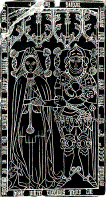
English (Barlow, Derbyshire), Memorial to Robert and Margaret Barley,
1467, incised brass
plaque, represented by a rubbing
(frottage). Robert Barley
is wearing the Yorkist collar of suns and roses is shown, attesting
the deceased's connections with the Yorkist royal line. See memorial.
Ercole de' Roberti (Italian, Ferrara, c. 1456-1496), Group Portrait: Members of the Este Family, pen, brown ink, 20.5 x 21 cm, Hermitage Museum, St. Petersburg, Russia. See drawing and Renaissance.

Albrecht Dürer (German, 1471-1528), The Walk, c. 1496-1498, 195 x 120 cm,
engraving, Hermitage
Museum, St. Petersburg, Russia. See drapery
and Northern
Renaissance.
Flanders, Chasuble with Orphreys, early 16th century, canvas, gilt and silk thread, or nue (shaded gold) technique, patterned and obverse, needlework, 113 x 69 cm, Hermitage Museum, St. Petersburg, Russia.
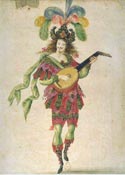
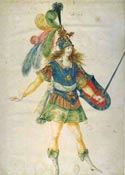

French, Lute Player, the Warrior, and Apollo, drawings of costumes for the Ballet
royal de la nuit (Royal Ballet of the Night), c. 1650,
Bibliotheque Nationale France, Paris. The ballet ends with the
appearance of Aurore, who yields her place to the rising sun — Apollo — played the premiere performance by the young King
Louis XIV — popularly known ever since as "The Sun King." See Baroque, dance, and theater.

China, Chuba, Qing
dynasty (1644-1911), 17th century, cut velvet with patterned wefts
of multicolored silks, gold-wrapped
silk, and peacock-feather filaments,
width 55 inches (139.7 cm),
Metropolitan Museum of Art, NY. See Chinese
art.

France, Chasuble, late 17th century, silk, silver-gilt
and silk thread, couching, satin stitch, 98 x 89 cm, Hermitage
Museum, St. Petersburg, Russia.

Japan, Noh robe (Nuihaku), Edo
period (1615-1868), second half of the 18th century, silk
embroidery and gold leaf on satin, height
61 1/4 inches (155.6 cm), width
at sleeves 21 1/8 inches (53.7 cm), Metropolitan Museum of Art,
NY. See Japanese
art.

France, Costume Armor, c. 1780-90, Metropolitan
Museum of Art, NY. This Greco-Roman style
armor
is typical of costumes made across Europe from the Renaissance to the late Baroque periods for tournaments, ballets,
and other court pageants.
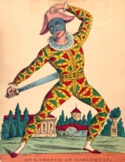
English, Mr. G. French as Harlequin, early 19th century, hand-colored engraving, 21.7 x 17.5 cm, New York Public Library.

American, Afternoon Dress, c. 1850s-60s,
two-piece, red silk, cage-type skirt hoop to emphasize the fullness
behind and includes a train at the floor to carry out the effect.
The most noticeable change in women's fashions at this time was
the transition in the shape of the skirt from the full circular
style to one in which the fullness is at the back. In addition,
double sleeves were adapted from men's fashions where the shirt
cuffs protruded beyond the sleeves of the jacket. Here the undersleeve,
or "engageant," is of lace.
Rendered by Nancy Crimi, Afternoon Dress, 1935/1942, watercolor and graphite
on paper, 44.5 x 35 cm (17 1/2
x 13 3/4 inches), Index of American Design, National Gallery
of Art, Washington, Dc. See Index
of American Design.

American, Hoop, c. 1865, half circles
of reeds or whalebone riveted to bands of heavy linen tape. It
is fastened at the waist with a steel buckle. This is an example
of a cage-hoop used underneath a skirt to provide fullness at
the back of a woman's dress. An important effect of the hoop
was the graceful, swinging motion it gave to a woman's skirt
as she walked. Rendered by Mae Szilvasy, Hoop, 1935/1942, watercolor and graphite
on paperboard, 38.8 x 31 cm (15 1/4 x 12 3/16 inches), Index
of American Design, National Gallery of Art, Washington, DC.
See fashion and
Index of American Design.
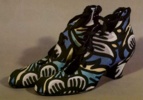
Wiener Werkstätte, pair of ladies shoes, c. 1914, printed silk fabric, leather. The Wiener Werkstätte was a collective of designers who championed the Viennese Secession.
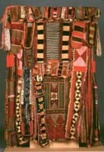
Ogbomoso, Nigeria, Yoruba, Egungun Costume, c. 1930-60, cloth, wood, and buttons, height c. 60 inches (152.4 cm), North Carolina Art Museum, Raleigh. A view of the back. See African art.
Also see arms and armor, chiton, couturier, crown, dance, fashion, feather, himation, leather, mantle, peplos, puppet, smock, statue, tartan, and textile.
https://inform.quest/_art
Copyright © 1996-![]()